Business and Business Environment 22: Tesco, Shell, BP Analysis Report
VerifiedAdded on 2022/10/19
|26
|6687
|13
Report
AI Summary
This comprehensive report provides a detailed analysis of public, private, and voluntary organizations, exploring their structures, functions, and objectives. It delves into the relationship between organizational functions and their impact on business objectives, using Tesco as a case study. The report examines macro-environmental factors through PESTEL analysis and assesses micro-environmental factors via SWOT analysis, comparing Tesco and Shell Energy. It also includes a critical evaluation of how macro and micro-economic factors influence decision-making within organizations, providing recommendations and insights for strategic planning. The report concludes with a discussion on the influence of structural design and external factors on organizational size and objectives.
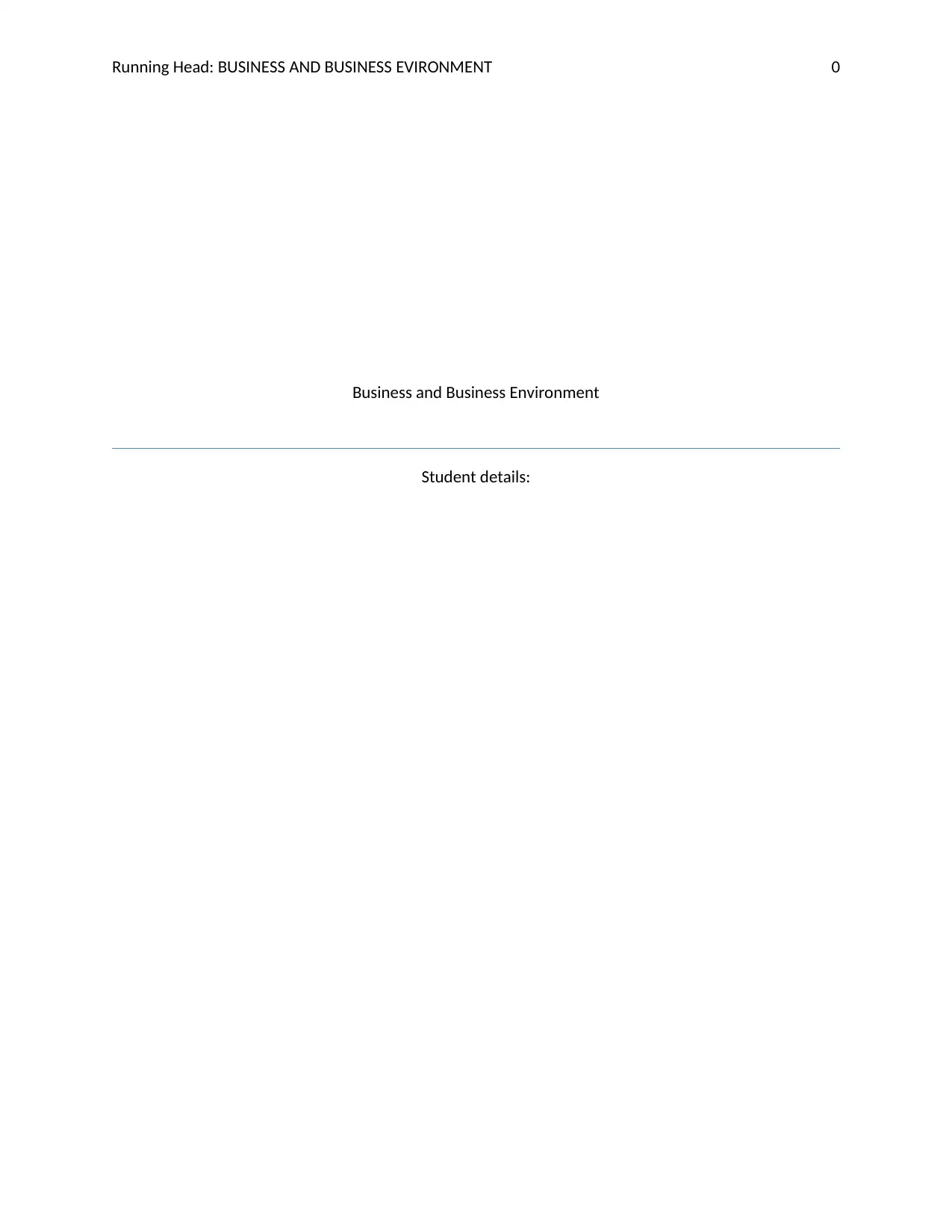
Running Head: BUSINESS AND BUSINESS EVIRONMENT 0
Business and Business Environment
Student details:
Business and Business Environment
Student details:
Paraphrase This Document
Need a fresh take? Get an instant paraphrase of this document with our AI Paraphraser

BUSINESS AND BUSINESS EVIRONMENT 1
Contents
Introduction......................................................................................................................................2
Organization....................................................................................................................................2
Types of organization...................................................................................................................2
Scope and size of organization.....................................................................................................7
Organizational Functioning.............................................................................................................9
Relationship between different organizational functions.............................................................9
Effect of the organizational functions over objectives and structure of Tesco............................9
Reform in Tesco.........................................................................................................................10
Advantages and disadvantages of interrelationship between organizational functions.............10
Complexities faced by different types of business structures....................................................11
Macro Environment.......................................................................................................................11
PESTEL.....................................................................................................................................12
PESTEL analysis on Tesco........................................................................................................13
Micro Environment........................................................................................................................16
SWOT analysis over Tesco (UK)..............................................................................................16
SWOT Analysis of Shell Energy (UK)......................................................................................17
Similarities and difference between the both SWOT analysis...................................................17
Recommendation for SWOT and PESTEL...............................................................................18
Application of SWOT analysis and justification to its influence over decision making...........18
SWOT analysis of British Petroleum.........................................................................................19
SWOT analysis of Engie (UK)..................................................................................................19
Similarities and difference between SWOT analysis of BP and Engie.....................................20
Relationship between Structural Design and the factors determining size of an organization..20
Influence of macro and micro factors over the objectives and decision making process in an
organization................................................................................................................................21
Conclusion.....................................................................................................................................22
Bibliography..................................................................................................................................23
Contents
Introduction......................................................................................................................................2
Organization....................................................................................................................................2
Types of organization...................................................................................................................2
Scope and size of organization.....................................................................................................7
Organizational Functioning.............................................................................................................9
Relationship between different organizational functions.............................................................9
Effect of the organizational functions over objectives and structure of Tesco............................9
Reform in Tesco.........................................................................................................................10
Advantages and disadvantages of interrelationship between organizational functions.............10
Complexities faced by different types of business structures....................................................11
Macro Environment.......................................................................................................................11
PESTEL.....................................................................................................................................12
PESTEL analysis on Tesco........................................................................................................13
Micro Environment........................................................................................................................16
SWOT analysis over Tesco (UK)..............................................................................................16
SWOT Analysis of Shell Energy (UK)......................................................................................17
Similarities and difference between the both SWOT analysis...................................................17
Recommendation for SWOT and PESTEL...............................................................................18
Application of SWOT analysis and justification to its influence over decision making...........18
SWOT analysis of British Petroleum.........................................................................................19
SWOT analysis of Engie (UK)..................................................................................................19
Similarities and difference between SWOT analysis of BP and Engie.....................................20
Relationship between Structural Design and the factors determining size of an organization..20
Influence of macro and micro factors over the objectives and decision making process in an
organization................................................................................................................................21
Conclusion.....................................................................................................................................22
Bibliography..................................................................................................................................23
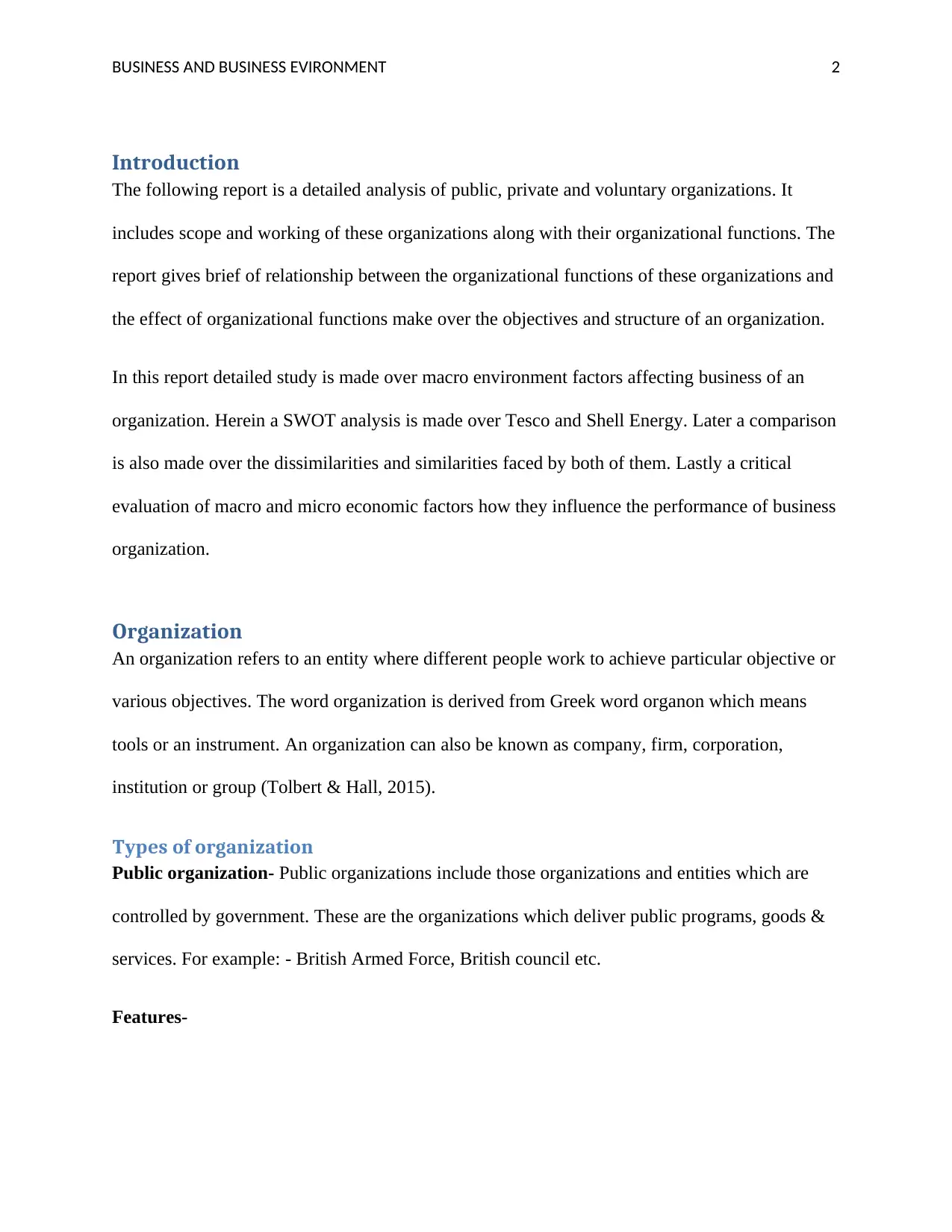
BUSINESS AND BUSINESS EVIRONMENT 2
Introduction
The following report is a detailed analysis of public, private and voluntary organizations. It
includes scope and working of these organizations along with their organizational functions. The
report gives brief of relationship between the organizational functions of these organizations and
the effect of organizational functions make over the objectives and structure of an organization.
In this report detailed study is made over macro environment factors affecting business of an
organization. Herein a SWOT analysis is made over Tesco and Shell Energy. Later a comparison
is also made over the dissimilarities and similarities faced by both of them. Lastly a critical
evaluation of macro and micro economic factors how they influence the performance of business
organization.
Organization
An organization refers to an entity where different people work to achieve particular objective or
various objectives. The word organization is derived from Greek word organon which means
tools or an instrument. An organization can also be known as company, firm, corporation,
institution or group (Tolbert & Hall, 2015).
Types of organization
Public organization- Public organizations include those organizations and entities which are
controlled by government. These are the organizations which deliver public programs, goods &
services. For example: - British Armed Force, British council etc.
Features-
Introduction
The following report is a detailed analysis of public, private and voluntary organizations. It
includes scope and working of these organizations along with their organizational functions. The
report gives brief of relationship between the organizational functions of these organizations and
the effect of organizational functions make over the objectives and structure of an organization.
In this report detailed study is made over macro environment factors affecting business of an
organization. Herein a SWOT analysis is made over Tesco and Shell Energy. Later a comparison
is also made over the dissimilarities and similarities faced by both of them. Lastly a critical
evaluation of macro and micro economic factors how they influence the performance of business
organization.
Organization
An organization refers to an entity where different people work to achieve particular objective or
various objectives. The word organization is derived from Greek word organon which means
tools or an instrument. An organization can also be known as company, firm, corporation,
institution or group (Tolbert & Hall, 2015).
Types of organization
Public organization- Public organizations include those organizations and entities which are
controlled by government. These are the organizations which deliver public programs, goods &
services. For example: - British Armed Force, British council etc.
Features-
⊘ This is a preview!⊘
Do you want full access?
Subscribe today to unlock all pages.

Trusted by 1+ million students worldwide
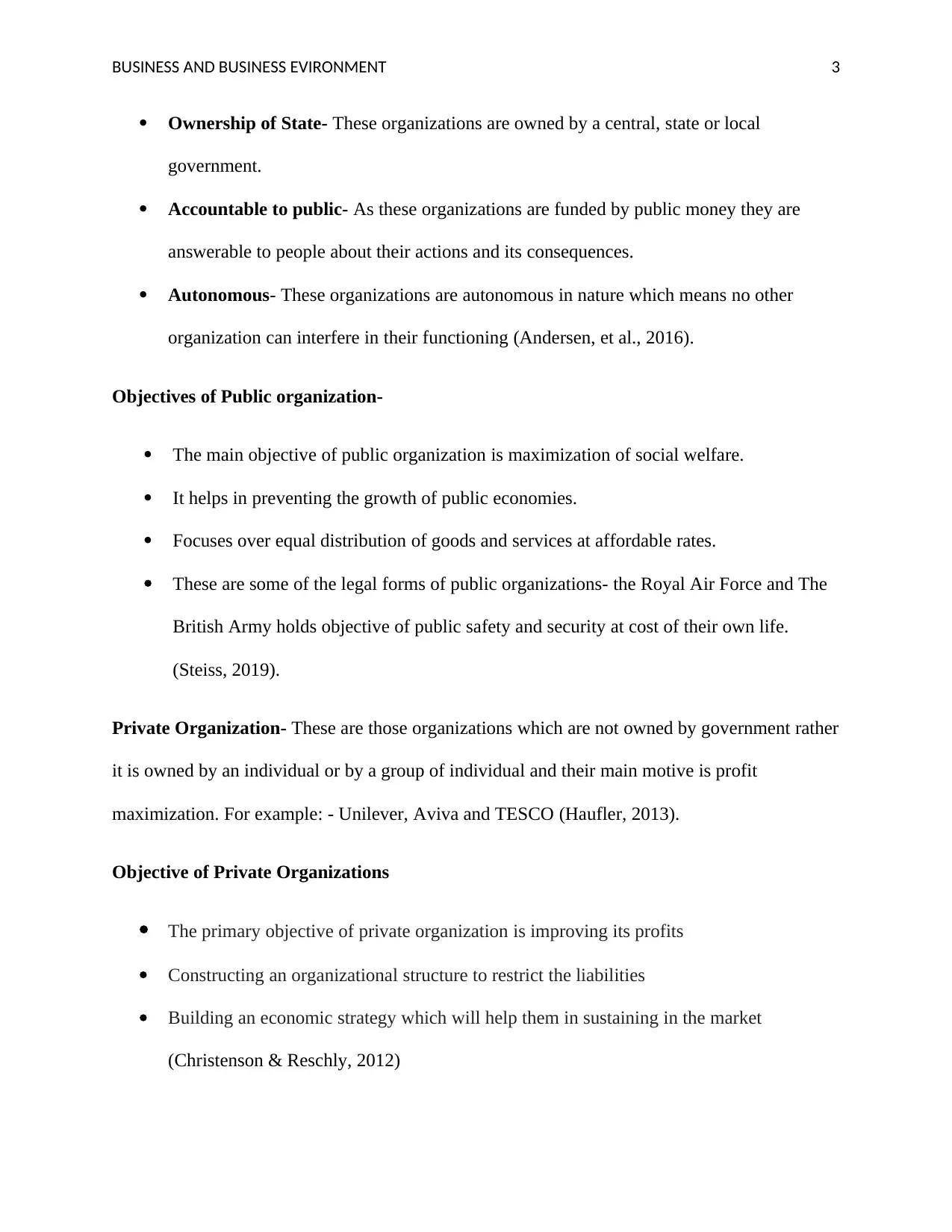
BUSINESS AND BUSINESS EVIRONMENT 3
Ownership of State- These organizations are owned by a central, state or local
government.
Accountable to public- As these organizations are funded by public money they are
answerable to people about their actions and its consequences.
Autonomous- These organizations are autonomous in nature which means no other
organization can interfere in their functioning (Andersen, et al., 2016).
Objectives of Public organization-
The main objective of public organization is maximization of social welfare.
It helps in preventing the growth of public economies.
Focuses over equal distribution of goods and services at affordable rates.
These are some of the legal forms of public organizations- the Royal Air Force and The
British Army holds objective of public safety and security at cost of their own life.
(Steiss, 2019).
Private Organization- These are those organizations which are not owned by government rather
it is owned by an individual or by a group of individual and their main motive is profit
maximization. For example: - Unilever, Aviva and TESCO (Haufler, 2013).
Objective of Private Organizations
The primary objective of private organization is improving its profits
Constructing an organizational structure to restrict the liabilities
Building an economic strategy which will help them in sustaining in the market
(Christenson & Reschly, 2012)
Ownership of State- These organizations are owned by a central, state or local
government.
Accountable to public- As these organizations are funded by public money they are
answerable to people about their actions and its consequences.
Autonomous- These organizations are autonomous in nature which means no other
organization can interfere in their functioning (Andersen, et al., 2016).
Objectives of Public organization-
The main objective of public organization is maximization of social welfare.
It helps in preventing the growth of public economies.
Focuses over equal distribution of goods and services at affordable rates.
These are some of the legal forms of public organizations- the Royal Air Force and The
British Army holds objective of public safety and security at cost of their own life.
(Steiss, 2019).
Private Organization- These are those organizations which are not owned by government rather
it is owned by an individual or by a group of individual and their main motive is profit
maximization. For example: - Unilever, Aviva and TESCO (Haufler, 2013).
Objective of Private Organizations
The primary objective of private organization is improving its profits
Constructing an organizational structure to restrict the liabilities
Building an economic strategy which will help them in sustaining in the market
(Christenson & Reschly, 2012)
Paraphrase This Document
Need a fresh take? Get an instant paraphrase of this document with our AI Paraphraser

BUSINESS AND BUSINESS EVIRONMENT 4
Types of Private Sector Organizations
There are different types of public sector organizations some of them are mentioned below:-
Sole traders- It is type of business organization where a single individual is liable to all profits,
losses and other issues of an organization as he is the only owner of the company like dust &
dance and Adnil creations are the most popular sole trading organizations of UK. The legal
structure of sole is similar to that of the business. The owner is personally liable to every loss and
profit.
Partnership- According to this type of business structure, two or more individuals forms a legal
relationship in order to carry on a business. All the partners have a share in the business as all of
them have made investment in the business. For example whatsapp and mumsnet were founded
in partnership.
The partnership is further divided into 3 sub parts- general partnership, limited partnership and
limited liability partnership. The general partnership gives equal rights and opportunities to all
the owners. All of them are liable to each profit and loss faced by the company. As per the
‘Partnership Act 1890’ a partnership remains in between people who have a common view point
and the partners have unlimited liability in the firm (Legislation, 2019).The limited partnership
allows every partner to limit his/ her personal liability to the ratio made by them in business
investment. Lastly Limited Liability Partnership is slightly different from the general partnership
because of the legal structure states that every partner has a limited or reduced financial liability.
(Legislation, 2019).
Types of Private Sector Organizations
There are different types of public sector organizations some of them are mentioned below:-
Sole traders- It is type of business organization where a single individual is liable to all profits,
losses and other issues of an organization as he is the only owner of the company like dust &
dance and Adnil creations are the most popular sole trading organizations of UK. The legal
structure of sole is similar to that of the business. The owner is personally liable to every loss and
profit.
Partnership- According to this type of business structure, two or more individuals forms a legal
relationship in order to carry on a business. All the partners have a share in the business as all of
them have made investment in the business. For example whatsapp and mumsnet were founded
in partnership.
The partnership is further divided into 3 sub parts- general partnership, limited partnership and
limited liability partnership. The general partnership gives equal rights and opportunities to all
the owners. All of them are liable to each profit and loss faced by the company. As per the
‘Partnership Act 1890’ a partnership remains in between people who have a common view point
and the partners have unlimited liability in the firm (Legislation, 2019).The limited partnership
allows every partner to limit his/ her personal liability to the ratio made by them in business
investment. Lastly Limited Liability Partnership is slightly different from the general partnership
because of the legal structure states that every partner has a limited or reduced financial liability.
(Legislation, 2019).
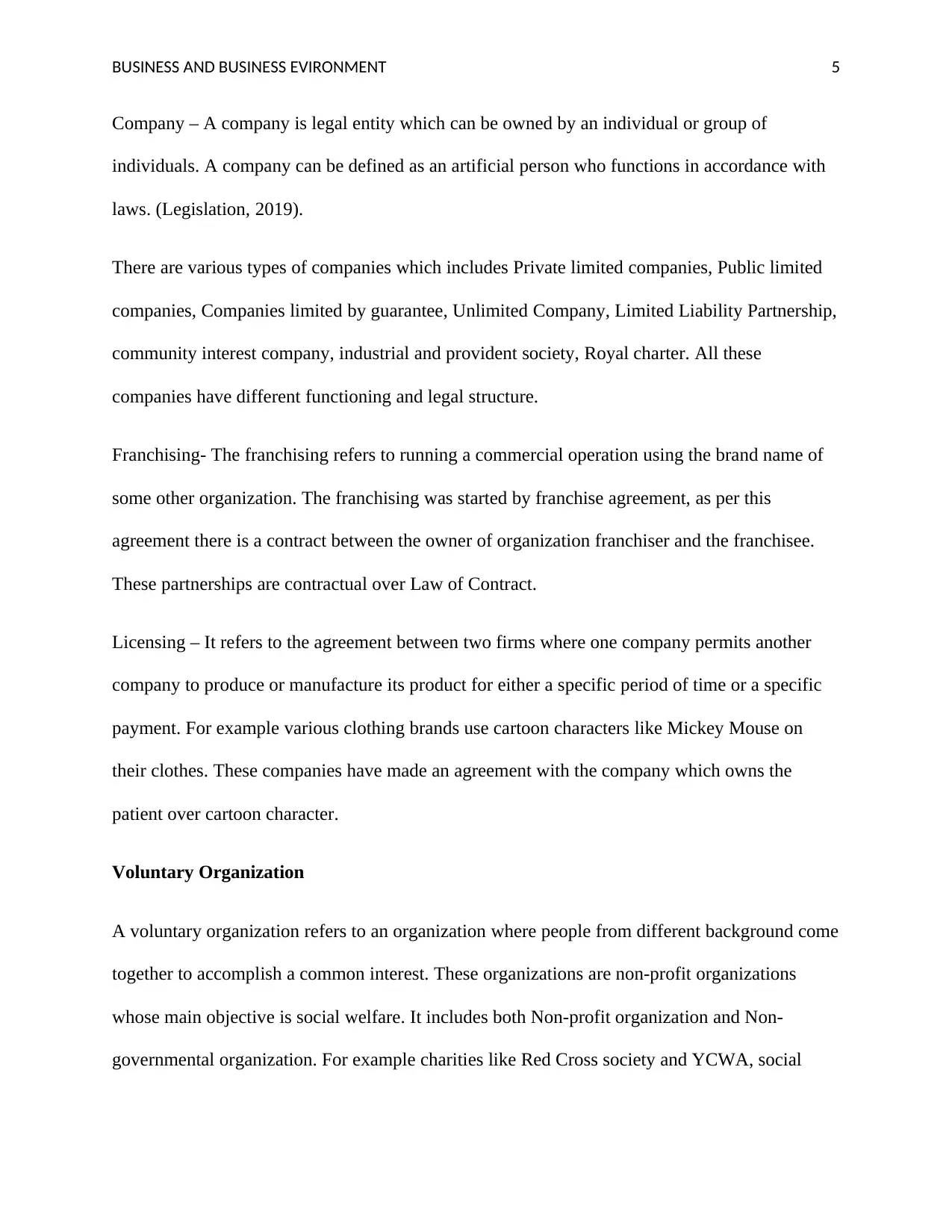
BUSINESS AND BUSINESS EVIRONMENT 5
Company – A company is legal entity which can be owned by an individual or group of
individuals. A company can be defined as an artificial person who functions in accordance with
laws. (Legislation, 2019).
There are various types of companies which includes Private limited companies, Public limited
companies, Companies limited by guarantee, Unlimited Company, Limited Liability Partnership,
community interest company, industrial and provident society, Royal charter. All these
companies have different functioning and legal structure.
Franchising- The franchising refers to running a commercial operation using the brand name of
some other organization. The franchising was started by franchise agreement, as per this
agreement there is a contract between the owner of organization franchiser and the franchisee.
These partnerships are contractual over Law of Contract.
Licensing – It refers to the agreement between two firms where one company permits another
company to produce or manufacture its product for either a specific period of time or a specific
payment. For example various clothing brands use cartoon characters like Mickey Mouse on
their clothes. These companies have made an agreement with the company which owns the
patient over cartoon character.
Voluntary Organization
A voluntary organization refers to an organization where people from different background come
together to accomplish a common interest. These organizations are non-profit organizations
whose main objective is social welfare. It includes both Non-profit organization and Non-
governmental organization. For example charities like Red Cross society and YCWA, social
Company – A company is legal entity which can be owned by an individual or group of
individuals. A company can be defined as an artificial person who functions in accordance with
laws. (Legislation, 2019).
There are various types of companies which includes Private limited companies, Public limited
companies, Companies limited by guarantee, Unlimited Company, Limited Liability Partnership,
community interest company, industrial and provident society, Royal charter. All these
companies have different functioning and legal structure.
Franchising- The franchising refers to running a commercial operation using the brand name of
some other organization. The franchising was started by franchise agreement, as per this
agreement there is a contract between the owner of organization franchiser and the franchisee.
These partnerships are contractual over Law of Contract.
Licensing – It refers to the agreement between two firms where one company permits another
company to produce or manufacture its product for either a specific period of time or a specific
payment. For example various clothing brands use cartoon characters like Mickey Mouse on
their clothes. These companies have made an agreement with the company which owns the
patient over cartoon character.
Voluntary Organization
A voluntary organization refers to an organization where people from different background come
together to accomplish a common interest. These organizations are non-profit organizations
whose main objective is social welfare. It includes both Non-profit organization and Non-
governmental organization. For example charities like Red Cross society and YCWA, social
⊘ This is a preview!⊘
Do you want full access?
Subscribe today to unlock all pages.

Trusted by 1+ million students worldwide

BUSINESS AND BUSINESS EVIRONMENT 6
welfare organizations like Human Rights Watch and Environmental Protection Agency (EPA)
(Legislation, 2019).
Objectives of Voluntary Organizations
Provides services to the public- These organizations provide aid to the needy people.
Increase in the standard of living- Helps people living who are below the basic standard
of living and provide them basic facilities.
Helps in promoting legal, economic, cultural and social objectives
Types of Voluntary Organization
Non-profit organization (NPO) - An organization whose main objective is to provide help to
specific group of people who have an unambiguous necessity.
Non-governmental organization (NGO)- These organizations are owned by a group or
community of people who work for social welfare. These organizations functions on every
aspect including educational, religious, charitable and social works.
Distinction between NPO and NGO
Basis of distinction NGO NPO
welfare organizations like Human Rights Watch and Environmental Protection Agency (EPA)
(Legislation, 2019).
Objectives of Voluntary Organizations
Provides services to the public- These organizations provide aid to the needy people.
Increase in the standard of living- Helps people living who are below the basic standard
of living and provide them basic facilities.
Helps in promoting legal, economic, cultural and social objectives
Types of Voluntary Organization
Non-profit organization (NPO) - An organization whose main objective is to provide help to
specific group of people who have an unambiguous necessity.
Non-governmental organization (NGO)- These organizations are owned by a group or
community of people who work for social welfare. These organizations functions on every
aspect including educational, religious, charitable and social works.
Distinction between NPO and NGO
Basis of distinction NGO NPO
Paraphrase This Document
Need a fresh take? Get an instant paraphrase of this document with our AI Paraphraser
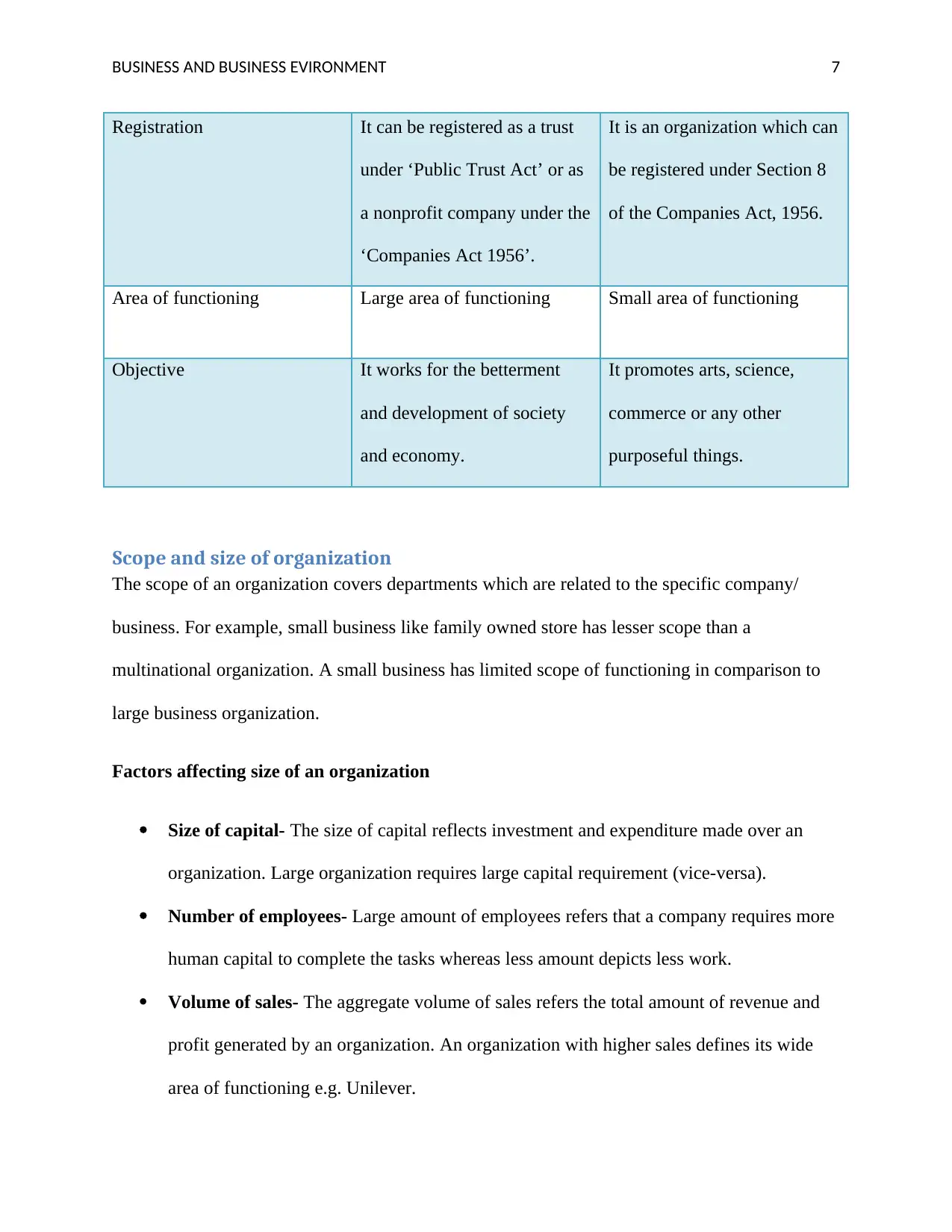
BUSINESS AND BUSINESS EVIRONMENT 7
Registration It can be registered as a trust
under ‘Public Trust Act’ or as
a nonprofit company under the
‘Companies Act 1956’.
It is an organization which can
be registered under Section 8
of the Companies Act, 1956.
Area of functioning Large area of functioning Small area of functioning
Objective It works for the betterment
and development of society
and economy.
It promotes arts, science,
commerce or any other
purposeful things.
Scope and size of organization
The scope of an organization covers departments which are related to the specific company/
business. For example, small business like family owned store has lesser scope than a
multinational organization. A small business has limited scope of functioning in comparison to
large business organization.
Factors affecting size of an organization
Size of capital- The size of capital reflects investment and expenditure made over an
organization. Large organization requires large capital requirement (vice-versa).
Number of employees- Large amount of employees refers that a company requires more
human capital to complete the tasks whereas less amount depicts less work.
Volume of sales- The aggregate volume of sales refers the total amount of revenue and
profit generated by an organization. An organization with higher sales defines its wide
area of functioning e.g. Unilever.
Registration It can be registered as a trust
under ‘Public Trust Act’ or as
a nonprofit company under the
‘Companies Act 1956’.
It is an organization which can
be registered under Section 8
of the Companies Act, 1956.
Area of functioning Large area of functioning Small area of functioning
Objective It works for the betterment
and development of society
and economy.
It promotes arts, science,
commerce or any other
purposeful things.
Scope and size of organization
The scope of an organization covers departments which are related to the specific company/
business. For example, small business like family owned store has lesser scope than a
multinational organization. A small business has limited scope of functioning in comparison to
large business organization.
Factors affecting size of an organization
Size of capital- The size of capital reflects investment and expenditure made over an
organization. Large organization requires large capital requirement (vice-versa).
Number of employees- Large amount of employees refers that a company requires more
human capital to complete the tasks whereas less amount depicts less work.
Volume of sales- The aggregate volume of sales refers the total amount of revenue and
profit generated by an organization. An organization with higher sales defines its wide
area of functioning e.g. Unilever.

BUSINESS AND BUSINESS EVIRONMENT 8
Level of technology- The level of technology of large organizations is better than small
organizations as these organizations are required to provide best quality of services to the
consumers.
Raw materials- The quality and quantity of the raw material defines size of an
organization
Legal form of ownership- The form of ownership defines the size of an organization;
there are different types of legal structures like single ownership, partnership, franchising
etc. For example: - Unilever is founded by Lever brothers, Samuel van den and Antonius
Johannes Jurgens. This is partnership form of legal structure.
Scope of different organizations
Local company- A local company has limited area of functioning (city, town etc.), it has
limited amount of goods & services to offer.
National company- Deals only within national boundaries (only in UK, USA, Australia).
Variety of goods and services to offer to the consumers.
International company- Deals within the boarders as well as outside the nation. As the
area of functioning is broader the number of quality and quantity of goods offered is
wide.
Multinational company- Deals within 2 or more nations.
Global company- Deals worldwide around the globe (Hubka & Eder, 2012).
Effects of structure, size and scope on the objectives, products and services
The structure of a business organization influences the objectives, products and services of an
organization, for example Tesco UK follows hierarchical organizational structure. Herein the
Level of technology- The level of technology of large organizations is better than small
organizations as these organizations are required to provide best quality of services to the
consumers.
Raw materials- The quality and quantity of the raw material defines size of an
organization
Legal form of ownership- The form of ownership defines the size of an organization;
there are different types of legal structures like single ownership, partnership, franchising
etc. For example: - Unilever is founded by Lever brothers, Samuel van den and Antonius
Johannes Jurgens. This is partnership form of legal structure.
Scope of different organizations
Local company- A local company has limited area of functioning (city, town etc.), it has
limited amount of goods & services to offer.
National company- Deals only within national boundaries (only in UK, USA, Australia).
Variety of goods and services to offer to the consumers.
International company- Deals within the boarders as well as outside the nation. As the
area of functioning is broader the number of quality and quantity of goods offered is
wide.
Multinational company- Deals within 2 or more nations.
Global company- Deals worldwide around the globe (Hubka & Eder, 2012).
Effects of structure, size and scope on the objectives, products and services
The structure of a business organization influences the objectives, products and services of an
organization, for example Tesco UK follows hierarchical organizational structure. Herein the
⊘ This is a preview!⊘
Do you want full access?
Subscribe today to unlock all pages.

Trusted by 1+ million students worldwide
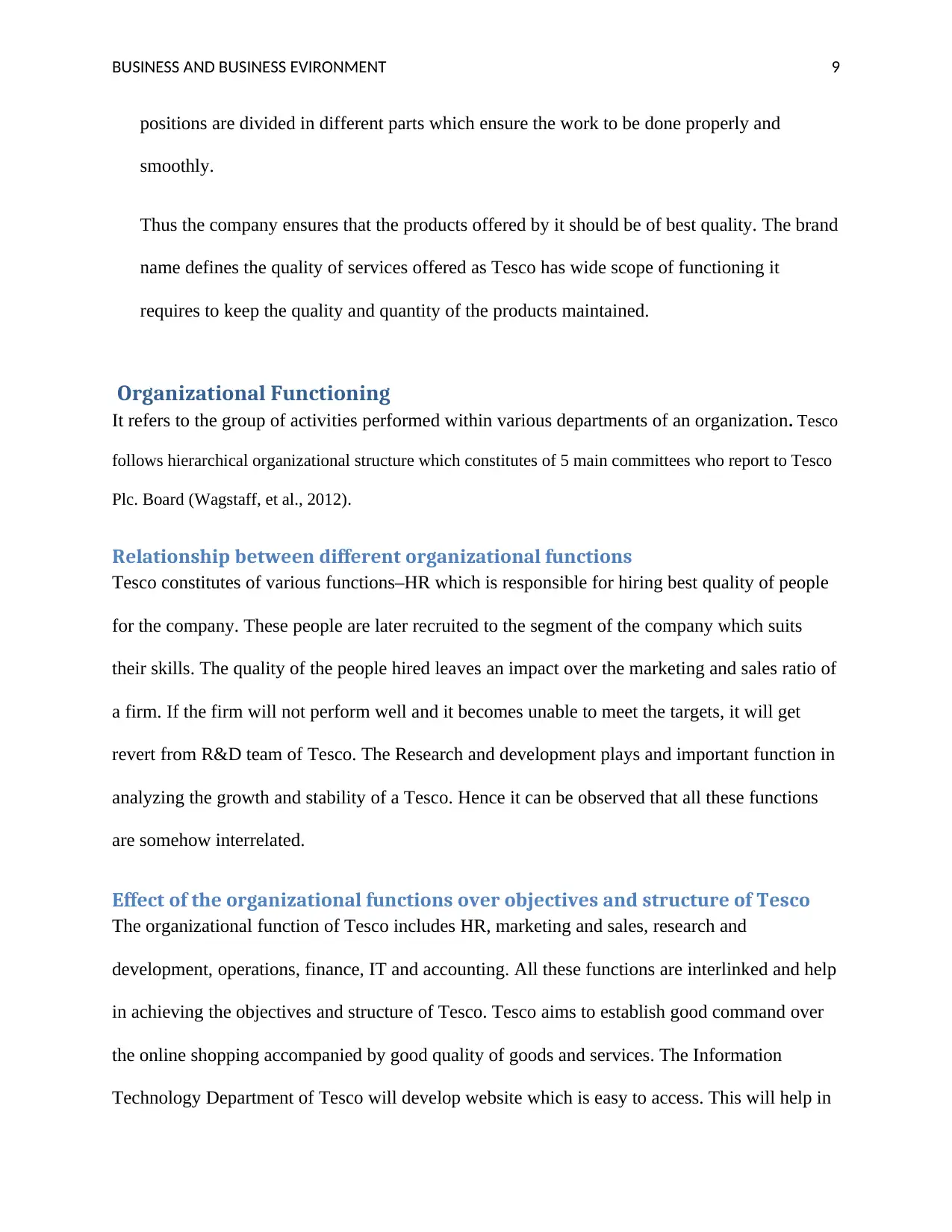
BUSINESS AND BUSINESS EVIRONMENT 9
positions are divided in different parts which ensure the work to be done properly and
smoothly.
Thus the company ensures that the products offered by it should be of best quality. The brand
name defines the quality of services offered as Tesco has wide scope of functioning it
requires to keep the quality and quantity of the products maintained.
Organizational Functioning
It refers to the group of activities performed within various departments of an organization. Tesco
follows hierarchical organizational structure which constitutes of 5 main committees who report to Tesco
Plc. Board (Wagstaff, et al., 2012).
Relationship between different organizational functions
Tesco constitutes of various functions–HR which is responsible for hiring best quality of people
for the company. These people are later recruited to the segment of the company which suits
their skills. The quality of the people hired leaves an impact over the marketing and sales ratio of
a firm. If the firm will not perform well and it becomes unable to meet the targets, it will get
revert from R&D team of Tesco. The Research and development plays and important function in
analyzing the growth and stability of a Tesco. Hence it can be observed that all these functions
are somehow interrelated.
Effect of the organizational functions over objectives and structure of Tesco
The organizational function of Tesco includes HR, marketing and sales, research and
development, operations, finance, IT and accounting. All these functions are interlinked and help
in achieving the objectives and structure of Tesco. Tesco aims to establish good command over
the online shopping accompanied by good quality of goods and services. The Information
Technology Department of Tesco will develop website which is easy to access. This will help in
positions are divided in different parts which ensure the work to be done properly and
smoothly.
Thus the company ensures that the products offered by it should be of best quality. The brand
name defines the quality of services offered as Tesco has wide scope of functioning it
requires to keep the quality and quantity of the products maintained.
Organizational Functioning
It refers to the group of activities performed within various departments of an organization. Tesco
follows hierarchical organizational structure which constitutes of 5 main committees who report to Tesco
Plc. Board (Wagstaff, et al., 2012).
Relationship between different organizational functions
Tesco constitutes of various functions–HR which is responsible for hiring best quality of people
for the company. These people are later recruited to the segment of the company which suits
their skills. The quality of the people hired leaves an impact over the marketing and sales ratio of
a firm. If the firm will not perform well and it becomes unable to meet the targets, it will get
revert from R&D team of Tesco. The Research and development plays and important function in
analyzing the growth and stability of a Tesco. Hence it can be observed that all these functions
are somehow interrelated.
Effect of the organizational functions over objectives and structure of Tesco
The organizational function of Tesco includes HR, marketing and sales, research and
development, operations, finance, IT and accounting. All these functions are interlinked and help
in achieving the objectives and structure of Tesco. Tesco aims to establish good command over
the online shopping accompanied by good quality of goods and services. The Information
Technology Department of Tesco will develop website which is easy to access. This will help in
Paraphrase This Document
Need a fresh take? Get an instant paraphrase of this document with our AI Paraphraser

BUSINESS AND BUSINESS EVIRONMENT 10
increasing the total sales of the company and will provide reliance to consumer. Thus because of
the following the objective of increasing sales and providing best quality to consumer will be
achieved. The development of proper web portals also helps in maintaining and managing the
hierarchical structure of the company.
Reform in Tesco
The major reform required in Tesco is to work upon the Research and development function. As
Tesco is one of the leading supermarket chains in UK, it should make an effort to know the
demands of the consumers. The main objective of company is to provide the consumers best
quality of goods and services so that he can get maximum level of satisfaction. The R&D
department should conduct a survey which will analyze the problems faced by consumers while
or after purchasing products .Once the research is conducted steps should be taken to solve the
problem raised by consumers. This will help in increasing the total sales of Tesco (Evans, et al.,
2018).
Advantages and disadvantages of interrelationship between organizational
functions
Advantages
Efficacy in work- The interrelationship between organizational functions of Tesco brings
efficiency and speed in work. The area of functioning is divided which makes functioning
easier.
Clarity- Each of them HR, finance and accounts have specific task to perform. Thus the
chances of confusion in delivering the services are reduced. The probabilities of
duplication of work condense which saves time of Tesco (Heider, 2017).
increasing the total sales of the company and will provide reliance to consumer. Thus because of
the following the objective of increasing sales and providing best quality to consumer will be
achieved. The development of proper web portals also helps in maintaining and managing the
hierarchical structure of the company.
Reform in Tesco
The major reform required in Tesco is to work upon the Research and development function. As
Tesco is one of the leading supermarket chains in UK, it should make an effort to know the
demands of the consumers. The main objective of company is to provide the consumers best
quality of goods and services so that he can get maximum level of satisfaction. The R&D
department should conduct a survey which will analyze the problems faced by consumers while
or after purchasing products .Once the research is conducted steps should be taken to solve the
problem raised by consumers. This will help in increasing the total sales of Tesco (Evans, et al.,
2018).
Advantages and disadvantages of interrelationship between organizational
functions
Advantages
Efficacy in work- The interrelationship between organizational functions of Tesco brings
efficiency and speed in work. The area of functioning is divided which makes functioning
easier.
Clarity- Each of them HR, finance and accounts have specific task to perform. Thus the
chances of confusion in delivering the services are reduced. The probabilities of
duplication of work condense which saves time of Tesco (Heider, 2017).

BUSINESS AND BUSINESS EVIRONMENT 11
Disadvantages-
Seclusion- The people working in different departments of Tesco do not get an
opportunity to come across and share their perspectives. This poses a threat over growth
of an organization.
Lack of synchronization- It often happens that the managers of these departments are
unable to deal with the problem faced by other department. As all of them are interlinked
synchronization is essential otherwise Tesco and its customers have to face challenges
(Bullmore & Sporns, 2012).
Complexities faced by different types of business structures
There are basically 4 types of business organizations sole proprietorship, partnership and
corporation. The sole ownership companies do not hold large capital investments. Therefore they
do not have different departments like HR and IT to handle different task. Moving forward to
partnership firms it becomes necessary for them to maintain data of almost every activity as in
partnership business the chances of conflicts between the co-owners is greater. The accounts and
finance department keeps every activity documented. Lastly there are corporations, corporations
are large business organizations, they have more work pressure. Hence it order to remove
duplicity from work and increase the efficiency to perform task it becomes mandatory for
corporation to do division of functions (Clayman, et al., 2012).
Disadvantages-
Seclusion- The people working in different departments of Tesco do not get an
opportunity to come across and share their perspectives. This poses a threat over growth
of an organization.
Lack of synchronization- It often happens that the managers of these departments are
unable to deal with the problem faced by other department. As all of them are interlinked
synchronization is essential otherwise Tesco and its customers have to face challenges
(Bullmore & Sporns, 2012).
Complexities faced by different types of business structures
There are basically 4 types of business organizations sole proprietorship, partnership and
corporation. The sole ownership companies do not hold large capital investments. Therefore they
do not have different departments like HR and IT to handle different task. Moving forward to
partnership firms it becomes necessary for them to maintain data of almost every activity as in
partnership business the chances of conflicts between the co-owners is greater. The accounts and
finance department keeps every activity documented. Lastly there are corporations, corporations
are large business organizations, they have more work pressure. Hence it order to remove
duplicity from work and increase the efficiency to perform task it becomes mandatory for
corporation to do division of functions (Clayman, et al., 2012).
⊘ This is a preview!⊘
Do you want full access?
Subscribe today to unlock all pages.

Trusted by 1+ million students worldwide
1 out of 26
Related Documents
Your All-in-One AI-Powered Toolkit for Academic Success.
+13062052269
info@desklib.com
Available 24*7 on WhatsApp / Email
![[object Object]](/_next/static/media/star-bottom.7253800d.svg)
Unlock your academic potential
Copyright © 2020–2025 A2Z Services. All Rights Reserved. Developed and managed by ZUCOL.




